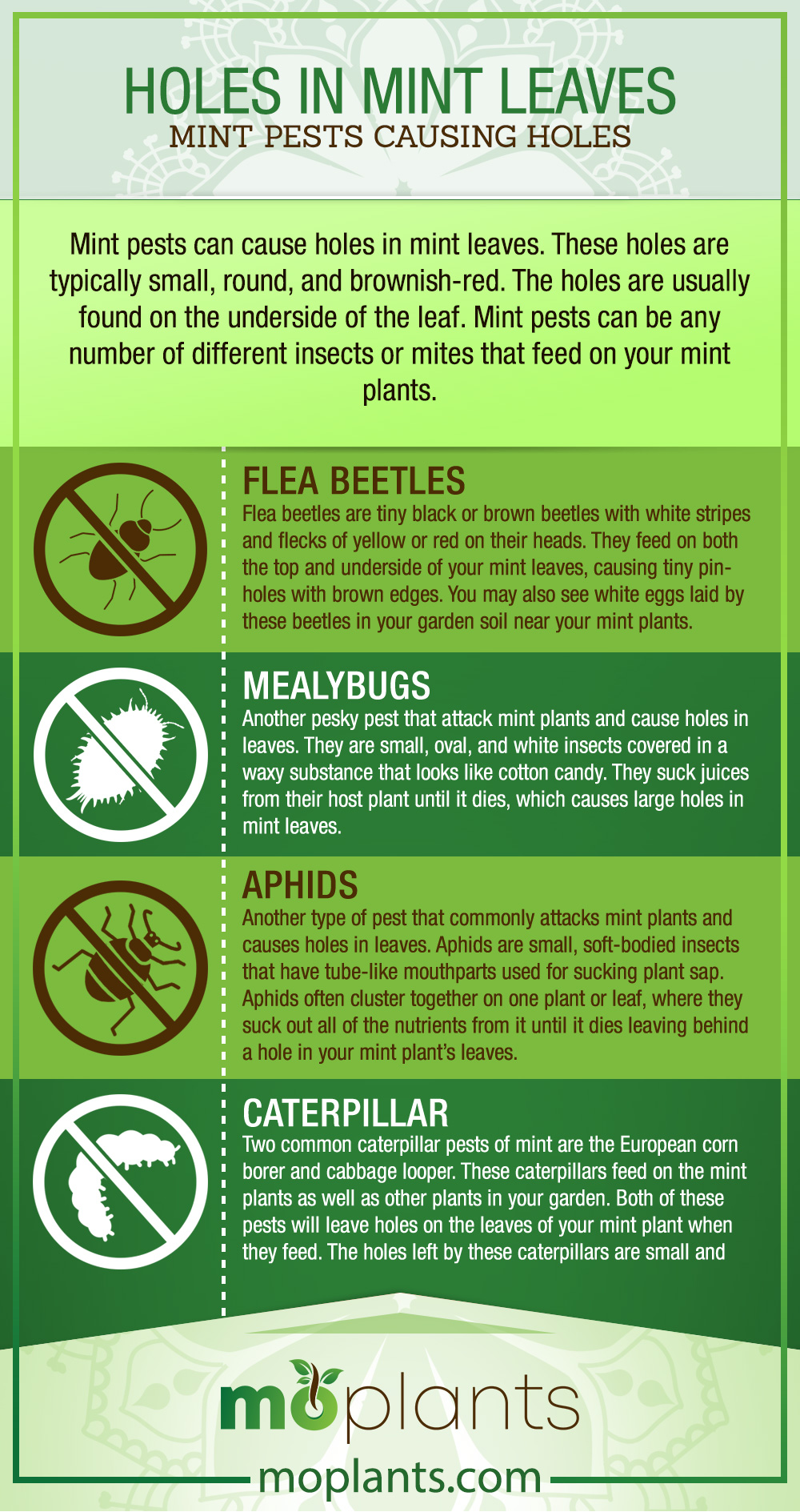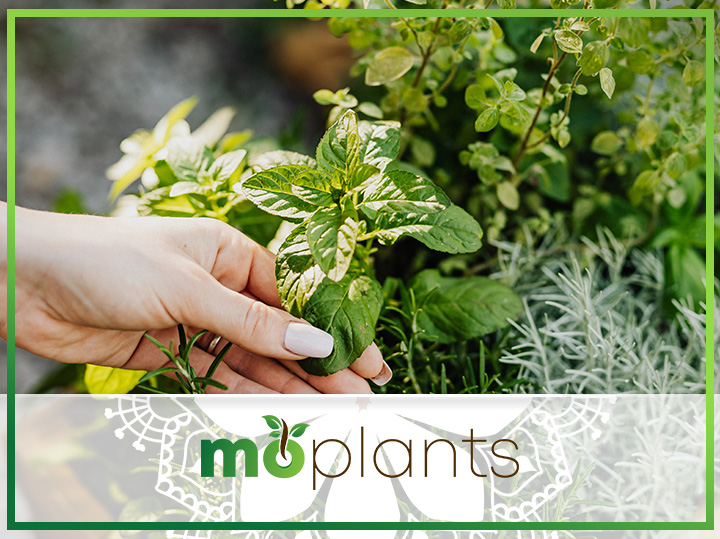Mint is an easy-to-grow herb with enormous benefits for the home gardener. As a perennial that grows in many climates, mint comes back every year without any special care from you. Fresh or dried mint leaves may be used to make tea, dress salads and meat meals, and flavor handmade pastries. But if your mint plants have holes in the leaves, it’s probably not because they are being munched on by insects. Read on to learn what’s causing mint leaf damage so you can repair the problem quickly and enjoy your delicious mint this growing season.
What’s Eating My Mint? (Holes in Mint Leaves)
You might first notice that your mint leaves have holes in them when you start to harvest. These are the result of pests or diseases. However, it’s important to recognize these pests before they damage your plant too badly.
Mint Pests Causing Holes
Mint pests can cause holes in mint leaves. These holes are typically small, round, and brownish-red. The holes are usually found on the underside of the leaf. Mint pests can be any number of different insects or mites that feed on your mint plants. The most common mint pests include:
- Flea Beetles – Flea beetles are tiny black or brown beetles with white stripes and flecks of yellow or red on their heads. They feed on both the top and underside of your mint leaves, causing tiny pinholes with brown edges. You may also see white eggs laid by these beetles in your garden soil near your mint plants. However, if you notice that there are many aphids on one leaf, try spraying some insecticide soap onto it and let it sit overnight before rinsing off tomorrow morning. This should help keep any more of them away from feeding on other parts of your plant.
- Mealybugs are another pesky pest that attack mint plants and cause holes in leaves. They are small, oval, and white insects covered in a waxy substance that looks like cotton candy. They suck juices from their host plant until it dies, which causes large holes in mint leaves.
- Aphids are another type of pest that commonly attacks mint plants and causes holes in leaves. Aphids are small, soft-bodied insects that have tube-like mouthparts used for sucking plant sap. Aphids often cluster together on one plant or leaf, where they suck out all of the nutrients from it until it dies leaving behind a hole in your mint plant’s leaves.
- Two common caterpillar pests of mint are the European corn borer and cabbage looper. These caterpillars feed on the mint plants as well as other plants in your garden. Both of these pests will leave holes on the leaves of your mint plant when they feed. The holes left by these caterpillars are small and round, often only having one hole per leaf.
Infographic

Holes In Leaves As A Result of a Disease
- If you have holes in your mint leaves, you may have leaf spot disease. Leaf spot is caused by several different kinds of fungi and bacteria that cause round brown spots on leaves as well as wilting and yellowing over time. These spots can also spread across multiple leaves or even the entire plant if left untreated.
- A fungal disease called powdery mildew can also infect mint plants and cause them to develop powdery white patches on their leaves and stems which spread quickly if left untreated.
- Another common disease that causes holes in mint leaves is downy mildew. Downy mildew affects all species of mint plants, including peppermint, spearmint, and apple-scented mints. This disease causes yellowing spots on the underside of the leaves as well as brown marks on top of them. When downy mildew develops on your plant’s leaves, you may treat it with fungicides to keep your plant healthy and happy.
- Botrytis blight causes dark brown spots to appear on the surface of the leaves. These spots eventually turn into black areas that get bigger and cover more of the plant. As they grow, they often leave brownish-gray streaks on the stems and other parts of the plant.
Solutions for Holes in Mint Leaves
- Spray the mint with water. This is an excellent option if your mint plants are outdoors and you don’t want to use insecticides or chemicals on them. Watering the plant regularly will help keep pest populations at bay, but it may not be enough if the infestation is severe.
- Use insecticidal soap. Insecticidal soap can be used for soft-bodied pests like aphids and whiteflies, but it does not work well against hard-bodied insects such as beetles or caterpillars. Apply according to label directions—usually once per week—and repeat as needed until all pests are gone.
- Use neem oil. Neem oil is derived from neem trees native to India; it’s been used for centuries as a natural pesticide because it has insecticidal properties. It interferes with insects’ ability to function correctly by altering hormones in their bodies; this makes them more vulnerable to predators such as birds or other bigger animals (such as cats). The best part? Neem has no harmful effect on humans.
Getting Rid of Bugs on Mint Leaves Naturally
Without a doubt, you’re planting mint to produce lovely smells and tastes in your meals. For these reasons alone, you may want to employ natural pest control methods rather than harsh pesticides.
We have a few ideas for you, all of which are successful methods of minimizing and removing insects from your mint plant.
- Garlic Spray
Garlic’s strong odor is a natural repellent to many mint pests, including beetles and spider mites. Consider garlic spray a prophylactic approach since it will repel pests before they settle themselves on your plant and lay eggs.
- Herbal Water Spray
Herbal sprays can be a good alternative to harsher pest control methods. Herbs, such as neem, which are naturally bitter, act as repellants. Some herbs contain essential oils that are toxic to insects and may kill them on contact.
- Oil Spray
Oil sprays are a very effective natural pesticide with fungicidal characteristics. They act by smothering soft-bodied insects like mites and mealybugs while not harming plant development or harming honey bees and butterflies.
- Neem Oil
Neem oil is derived from the neem tree and can be used to protect mint plants from pests such as mealybugs, aphids, thrips, and mites.
- Chili Pepper Spray
Hot, spicy foods are a major pest repellent, ensuring that your mint is foul-tasting and not worth the effort. If you’re having trouble with aphids, loopers, and other soft-bodied insects, pepper sprays are extremely helpful.
- Sticky Trap/ Flying Trap
Sticky traps will stop pests in their tracks. These are frequently glue-based and function by either repelling or trapping insects that get too close. Place them around your mint plant to create a protective barrier.
Flying traps are frequently put above and around your plant and are particularly effective against flying pests like moths and aphids.
- Diatomaceous Earth
Diatomaceous earth, a powder made from the fossilized skeletons of diatoms, can be sprinkled around your mint plant to get rid of ground-based pests like beetles, mites, snails, and more. Insects that walk over this powder ingest it and perish.
- Essential Oil
If you want to attract helpful insects, such as honeybees that pollinate flowers, while repelling pests from your garden, spray it with an essential oil mixture. Essential oils have strong scents like lavender and rosemary that most pests find displeasing.
- Soap Spray
One of the simplest and most efficient insect treatments for your mint plant is soap spray! It will kill mealybugs, aphids, caterpillars, and other pests. The only thing to keep in mind is that soap spray will kill insects on contact rather than repel them.
- Pyrethrin
Pyrethrin is a pesticide derived from the chrysanthemum flower that attacks the nervous system of insects on contact. It’s especially effective against moths and flies
Infographic

Preventing Mint Leaf Pest Attack
- Prune your mint plant regularly to keep it healthy and strong.
- Keep the soil moist but not soggy, as soggy soil will encourage whiteflies to lay their eggs in the soil of your mint plant, which can be damaging over time.
- Plant mint in pots so you can move them around if they get too much sun or too little light; this also prevents roots from becoming tangled in other plants nearby (which may cause damage).
- Avoid using pesticides on your plants; instead, use natural methods like predators that eat pests themselves (like ladybugs) instead of harmful chemicals that could make you sick if ingested by people or animals who come into contact with them through food preparation activities.
Takeaway
Given the many benefits of mint, from its ability to soothe muscle pain to its role in keeping bad breath at bay, there is no doubt that it is one of the most beneficial herbs out there. And with such a wide range of uses, it is imperative that you know how to tell the difference between healthy and unhealthy leaves. So do give your mint a checkup every now and then, and ensure that you plant only healthy leaves.
Mint is an easy-to-grow, delicious herb. While the signs of insect damage in mint are quite apparent, it is vital to be able to distinguish between pests and disease. Once you’ve identified the problem, you can take steps to deal with it.
We hope you found this article helpful and you will use our tips every time you are dealing with mint leaves.


